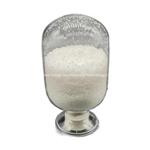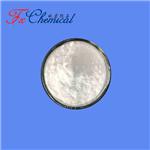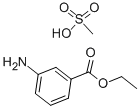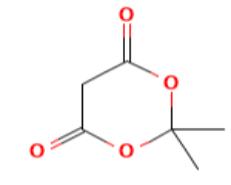Uses of Tricaine methanesulfonate
General description
Tricaine methanesulfonate (TMS), known also as MS-222, ethyl 3-aminobenzoate methanesulfonic acid, tricaine mesilate, Aqualife TMSTM (Syndel, Qualicum Beach, BC Canada) metacaine, methane- sulfonate, FinquelTM (Argent Chemical laboratories, Redmond, WA, USA), or Tricaine-STM (Western Chemical, Inc., Ferndale, WA, USA), is classified as an ester-type synthetic local anesthetic and is commonly used in the fisheries industry (1).
Tricaine methanesulfonate (TMS) is an anesthetic that is approved for provisional use in some jurisdictions such as the United States, Canada, and the United Kingdom (UK). Many hatcheries and research studies use TMS to immobilize fish for marking or transport and to suppress sensory systems during invasive procedures. Anesthetics are used to sedate fish during transport or handling, and immobilize fish for surgical procedures by depressing their central and peripheral nervous systems (2). This nervous system depression reduces voluntary movement and reduces sensory perception during the procedure (3).

Figure 1 the molecular formula of Tricaine Methanesulfonate
Designated uses
Guidelines and regulations regarding the use of TMS vary between manufactures and between countries. In the United States, TMS is the only legal anesthetic for use on a limited number of food fish (4,5). The limitations on TMS use with food fish include a 21-day withdrawal period before harvesting, and use is restricted to the families Ictaluridae (catfishes), Salmonidae (salmon, trout, char, whitefish, and grayling), Esocidae (pike and pickerel), and Percidae (perch, walleye, ruffe, and darters) (5). For other species, the drug should be limited to hatchery or laboratory applications in which fish will not be released into the wild or consumed. According to the U.S. Food and Drug Administration (FDA) and manufacturers, water temperatures during the 21-day withdrawal period should exceed 10°C (50°F; 5). However, a Freedom of Information Act factsheet (4) stated that water should not exceed 10°C (50°F) during the 21-day period. The reason for this discrepancy is not clear and possibly a typographical error. The authors were not successful at confirming this suspicion.
In Canada, TMS is the only approved drug for use in food fish and is sold under the name Aqualife TMSTM. The usage of TMS in food fish is limited to the family Salmonidae and is available only by veterinarian prescription. Treated fish cannot be slaughtered 5 days after the last exposure and must be held in water warmer than 10°C (6).
In the United Kingdom (UK), TMS is available for use in fin fish intended for human consumption and ornamental fish. The company PHARMAQ holds the only marketing authority to manufacture TMS in the UK, as granted by the Veterinary Medicines Directorate (7). According to the VMD summary of product characteristics sheet, TMS has a 70-degree day withdrawal period (or 7 days in water at mean temperatures of 10°C or higher) in the UK before harvesting (7).
Mechanism of action
Although classified as a local anesthetic, TMS acts systemically when absorbed through the gills and skin of fish (e.g., scaleless fish with well-vascularised skin) in an anesthetic bath. Once in the gills, TMS enters the bloodstream and is distributed throughout the body (8). Once inside the body, TMS concentrations are metabolized rapidly by acetylation reactions and excreted (9). The major excretion route for TMS and its non-polar metabolites is through the gills.
The major mode of action for TMS is nervous system suppression whereby the entrance of sodium (Na+) into the nerve is inhibited, thus limiting nerve membrane excitability (9). Nerve inhibition is facilitated by the lipid solubility of TMS, which allows it to move easily into the cell membrane to bind with sodium channels (8). In mammals, the loss of nerve function starts as a loss of the senses of pain, temperature, touch, and the loss of equilibrium and proprioception, followed by loss of skeletal muscle tone (10).
Storage and preparation
TMS is a white, odorless crystalline powder with a high solubility in water (1 g/0.8 mL of TMS at 20°C;
11%; 11,12). Storage areas for the powder form should be dark, dry, well-ventilated, and cool (12). TMS in powder form easily can become airborne and could become hazardous to the handler. Although there is evidence that TMS is not mutagenic, users should be aware that TMS is retinotoxic and an irritant to mucous membranes, including the upper respiratory tract (12). Prior to handling or using, one should read manufacturer-specific material safety data sheets (MSDSs) and avoid contact with the powder or solution by using accepted personal protective equipment. This can include gloves, eye protection, and general skin protection when dealing with all forms of the chemical; and masks and/or fume hoods when dealing with the powdered form (11,12). Additionally, hand washing after handling TMS, whether in powder or aqueous form, is recommended.
TMS is generally prepared as a concentrated stock solution of TMS and water. Some manufacturers agree that the TMS solution is photosensitive (its color changes with light exposure), although the color change does not necessarily indicate significant activity decrease (11-13) and thus color should not be used to gauge degradation. In contrast, Bell (1987) (14) stated that TMS solutions can be toxic to fishes in seawater with sunlight exposure, although no mechanism for this acquired toxicity was noted. Due to the difficulty of handling powdered TMS in situations in which proper personal protective equipment may not be readily available or practical to use (e.g., field settings), some researchers pre-mix and store TMS stock solutions in dark bottles.
Safety control
Some good examples of safe practices when working with MS-222 (Tricaine methanesulphonate):
• Wear protective clothing, gloves and goggles when handling the MS-222 powder.
• Work inside a fume hood to prepare the solution and stir until all powder is dissolved.
• Collect Tricaine in a bottle or request a hazardous waste container from EH&S.
• Wear gloves to handle animals exposed to MS-222.
• Do not discard MS-222 directly into sink, surface water, storm water conveyances, or catch basins.
References
1. Sato T, Kitayama S, Mitsuhata C, Ikeda T, Morita K, Dohi T (2000) Selective inhibition of monoamine neurotransmitter transport by synthetic local anesthetics. Naunyn-Schmiedeberg’s Arch Pharmacol 361:214–220.
2. Summerfelt RC, Smith LS (1990) Methods for fish biology. In: Schreck CB, Moyle PB (eds) Anesthesia, surgery and related techniques. American Fisheries Society, Bethesda, MD, pp 213–272
3. Sneddon LU (2002) Anatomical and electrophysiological analysis of the trigeminal nerve in a teleost fish, On- corhynchus mykiss. Neurosci Lett 319:167–171
4. FDA (U.S. Food and Drug Administration) (1997) Freedom of Information Summary for NADA 200-226.
5. FDA (U.S. Food and Drug Administration) (2006) Database of approved animal drug products. U.S. Department of Health and Human Services, Food and Drug Administration, Center for Veterinary Medicine. VMRCVM Drug Information Laboratory.
6. Health Canada (2010) List of veterinary drugs that are authorized for sale by health Canada for use in food-producing aquatic animals.
7. VMD (Veterinary Medicines Directorate) (2010a) Product Information Database.
8. Hunn JB, Allen JL (1974) Movement of drugs across the gills of fishes. Ann Rev Pharmacol 14:47–55
9. Burka JF, Hammel KL, Horsberg TE, Johnson GR, Rainnie DJ, Spears DJ (1997) Drugs in salmonid aquaculture–a review. J Vet Pharm Therap 20:333–349.
10. Rang HP, Dale MM, Ritter JM, Moore PK (2003) Chapter 43: local anesthetics. In: Rang HP, Dale MM, Ritter JM, Moore PK (eds) Pharmacology, 5th edn. Churchill Liv- ingstone, Edinburgh, Scotland
11. Argent (Argent Laboratories) (2008) Anesthetics and tranquilizers – Finquel (MS-222 or tricaine).
12. Sigma (2008) Material safety data sheet: ethyl 3-aminobenzoate methanesulfonate, E10521. Sigma-Aldrich Corporation.
13. Western (Western Chemical, Inc.) (2008a) Fact sheet: Tricaine-S.
14. Bell GR (1987) An outline of anesthetic and anesthesia for salmonids, a guide for fish culturists in British Columbia. Canadian Technical Report of Fisheries and Aquatic Sciences No. 1534
);You may like
Lastest Price from Tricaine methanesulfonate manufacturers

US $30.00/kg2024-02-27
- CAS:
- 886-86-2
- Min. Order:
- 1kg
- Purity:
- 99%
- Supply Ability:
- 100 tons

US $0.00/KG2023-11-15
- CAS:
- 886-86-2
- Min. Order:
- 1KG
- Purity:
- 98%min
- Supply Ability:
- 30tons/month

